Death and state funeral of Boris Yeltsin
This article needs additional citations for verification. (May 2019) |
You can help expand this article with text translated from the corresponding article in Russian. (February 2022) Click [show] for important translation instructions.
|
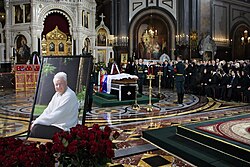 | |
| Date | 23–25 April 2007 |
|---|---|
| Location | Cathedral of Christ the Saviour and Novodevichy Cemetery, Moscow |
| Participants | Vladimir Putin, Sergey Sobyanin, Naina Yeltsina, Mikhail Fradkov, Dmitry Medvedev and others |
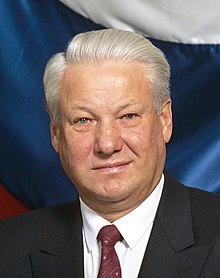
| ||
|---|---|---|
|
First term
Second term Post-Presidency |
||
Boris Yeltsin, the first President of Russia, died of cardiac arrest on 23 April 2007, twelve days after being admitted to the Central Clinical Hospital in Moscow. Yeltsin was the first Russian head of state to be buried in a church ceremony since Emperor Alexander III, 113 years prior.[1]
On the day Yeltsin died, President Vladimir Putin declared the day of his funeral, held on 25 April 2007,[2] to be a day of national mourning. The ceremony was broadcast live on the main Russian state TV channels, and was attended by current and former heads of state, with a number of them expressing their condolences. The lowering of the coffin into the grave was accompanied by an artillery salute.
Last illness and cause of death
Yeltsin died due to heart failure at 3:45 p.m., Moscow time, as a result of progressive multiple organ dysfunction syndrome.[3][4] Yeltsin was hospitalized for 12 days before his death.[5][6] He was mostly bedridden for the last week, experiencing a sharp deterioration in his health along with heart pain in the last three days. Yeltsin's condition improved slightly on the morning of his death, but then his heart stopped twice,[7] and doctors were unable to revive him the second time. According to Renat Akchurin, the heart surgeon who performed Yeltsin's bypass surgery in 1996, this heart failure was unexpected. An autopsy was carried out on the request of his relatives.
Shortly before his death, Yeltsin had traveled to the Middle East (Jordan, Israel and the Palestinian Territories), which may have contributed to his health deteriorating.[8]
President Vladimir Putin telephoned Yeltsin's widow Naina Yeltsina on 25 April 2007, to express his condolences. Others to express theirs were Angela Merkel, Jacques Chirac, George W. Bush, Lech Kaczyński, Helmut Kohl, Tony Blair and Bill Clinton. Students and staff of his native Urals State Technical University held a minute's silence and mourning to honor the former leader's memory.
Farewell ceremony and funeral service
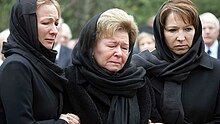
The day after his death, a farewell ceremony was held at the Cathedral of Christ the Savior, at 16:30 Moscow time. A half-couch casket and the Russian flag were placed in the center of the church, near a stand with Yeltsin's awards and portrait. The requiem liturgy was given by the Vicar of the Moscow Diocese Archbishop Arseny (Epifanov). An honor guard was present, formed of soldiers from the Kremlin Regiment. The church was open for viewing all evening and night, with around 25,000 people coming to pay their respects.[9] All through the memorial service, representatives were present to accept condolences to the Yeltsin family members: his widow Naina, daughters Elena Okulova and Tatyana Dyachenko, and his grandchildren.
After the civil ceremony, which ended at 12:30 p.m. on 25 April, there was a farewell held for officials and representatives of foreign states.
The funeral service was led by Metropolitan Krutitsy and Kolomna Juvenal (Poyarkov), assisted by Metropolitan Kirill (Gundyaev) and Clement (Kapalin). During the reading of the Psalms, the funeral rites and the liturgy, Yeltsin was remembered as "First President of Russia Boris Nikolayevich," as opposed to the usual "servant of God, Boris". This change emphasized the President as the modern Russian equivalent to the monarch: the use of titles and patronymic name was the same construction as the heave offerings that were given to the monarch and members of the royal house until the abdication of Tsar Nicholas II.
Burial
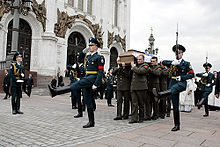
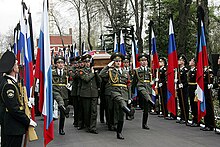

After the burial service, Yeltsin's coffin was closed and carried outside into a hearse which was then escorted through the Novodevichy streets by motorcyclists. Officers draped with the national flag on the hearse and placed it on a gun carriage, whereby it was drawn to the cemetery gates by an armored personnel carrier. From there, the funeral procession continued with the gun carriage being manoeuvred on foot. Yeltsin's coffin was removed and carried by eight officers, with a bell of the Novodevichy Convent. The procession continued to the central avenue to where the grave was, with a small hearse in front of it. The flag was taken from the coffin and handed over to Sergey Sobyanin, who in its turn gave it to Naina Yeltsina.
The coffin was taken down and opened again. Metropolitan Juvenal called Yeltsin's family to approach the body one last time, first Yelena Okulova, then Tatyana Dyachenko, and finally, widow Naina Yeltsina. After that a final memorial was performed by Mn. Juvenal, with Mns. Kirill and Kliment assisting, while "Eternal Memory" was sung by a female chorus from the Novodevichy Convent. Metropolitan Juvenal then put a small wreath on Yeltsin's brow. By about 16:30 p.m., the coffin was closed, adorned with flowers and lowered into the grave. An artillery salute of three volleys rang out and a military band played the Russian anthem.
Afterwards, at the reception in the Kremlin, Vladimir Putin gave his only speech.
Participants
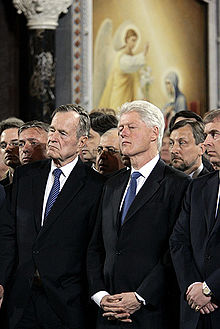
The ceremony was attended by more than thirty foreign visitors. These were the heads of state and government and other representatives of various countries, as well as many former heads of state and government, who had worked with Boris Yeltsin.
A total of 12 foreign leaders, 16 former leaders, 4 governmental delegates and 3 multilateral leaders attended the funeral. In total, 50 countries and 3 organizations was represented.
Also, in addition to foreign leaders, there were many Russian politicians.
Gallery
-
Coffin with the body of Boris Yeltsin in the Cathedral of Christ the Savior.
-
Prime Minister Fradkov and President Putin.
-
Yeltsin's coffin being taken to the cemetery.
-
Yeltsin family.
-
Bill Clinton, Vladimir Putin, wife Ludmila Putina and George H. W. Bush.
-
Vladimir Putin and his wife laying flowers on the grave.
-
Grave before installing the tombstone.
-
Vladimir Putin, Naina Yeltsina and Leonid Kuchma.
-
Vladimir Putin delivers a speech.
-
Yeltsin's tomb with Russian flag sculpture.
Memorials and Memory
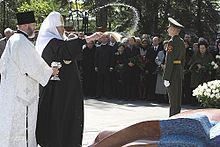
Yeltsin was memorialised in several ways in 2008. On 8 April, a street in Yekaterinburg, formerly 9 January Street, was renamed "Boris Yeltsin Street". On 23 April, a grand opening ceremony at Novodevichy Cemetery was held for the monument to Boris Yeltsin, made by sculptor Georgy Frangulyan. The memorial is a broad headstone, made in the colors of the Russian flag – a white marble, blue Byzantine mosaics and red porphyry. On the pavement under the tricolor is an engraved Orthodox cross. The ceremony was attended by Yeltsin's family, including his widow, Naina, Russian President Vladimir Putin, the president-elect Dmitry Medvedev, Prime Minister Viktor Zubkov, Chief of Staff of the Presidential Executive Office Sergey Sobyanin, government members, friends, colleagues and others who worked with Yelstin. On the same day, the name of the Ural State Technical University was changed to include "Boris Yeltsin".[10]
On 25 January 2015, the Boris Yeltsin Presidential Center opened in Yekaterinburg.[11]
See also
- Death and state funeral of Vladimir Lenin
- Death and state funeral of Joseph Stalin
- Death and state funeral of Leonid Brezhnev
- Death and funeral of Mikhail Gorbachev
References
- ^ "Yeltsin, the man who buried communism"
- ^ "Decree "On the declaration of mourning over the death of the first Russian President Boris Yeltsin and his funeral"". Archived from the original on 4 August 2012. Retrieved 8 April 2016.
- ^ It named the cause of the death of Boris Yeltsin.
- ^ It named the official cause of death of Boris Yeltsin
- ^ Yeltsin was hospitalized for 12 days before his death
- ^ Doctors fought for Boris Yeltsin's life 12 days
- ^ "Yeltsin's heart stopped twice". Archived from the original on 9 October 2007. Retrieved 2 February 2019.
- ^ The first president could not stand the heart (Russian) (Eng. The first president's heart couldn't take it.
- ^ "At Yeltsin's funeral were about 25 thousand people". Archived from the original on 14 February 2008. Retrieved 2 February 2019.
- ^ Ural State Technical University was given the name of Boris Yeltsin
- ^ Opening Yeltsin Center












